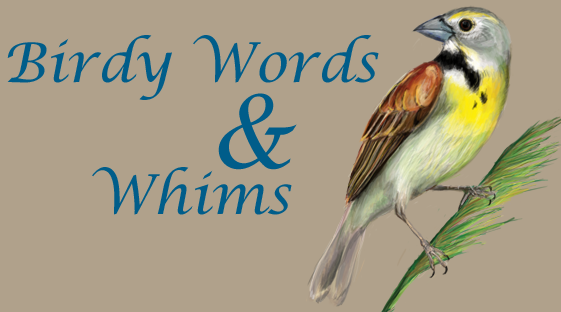I decided to move to Wordpress so I will no longer be updating on this site!!
Please follow me at http://birdyword.wordpress.com
Thanks!!
Saturday, November 13, 2010
Thursday, October 14, 2010
Happy Owl-ween!
What's a better way to spend Halloween than getting up close and personal with Wisconsin's smallest owl, the Northern Saw-whet Owl?
I will be leading an Audubon field trip to view a Saw-whet banding demonstration at Linwood Research Station in Stevens' Point on Friday October 29th and the public is welcome to join for a small fee of $10. We will be leaving Madison at 5pm and will return around midnight. Right now, I believe there is a waiting list, but we're spreading the field trip out over two nights. Contact Mara McDonald (mamcdona@wisc.edu) for further information.
I will be leading an Audubon field trip to view a Saw-whet banding demonstration at Linwood Research Station in Stevens' Point on Friday October 29th and the public is welcome to join for a small fee of $10. We will be leaving Madison at 5pm and will return around midnight. Right now, I believe there is a waiting list, but we're spreading the field trip out over two nights. Contact Mara McDonald (mamcdona@wisc.edu) for further information.
Sunday, August 15, 2010
Follow me for a month in Europe!
I'm happy to announce a new blog that Tim and I will be sharing!
http://stephandtimgoeurope.wordpress.com
We are going on a tour of Europe and leaving this Thursday (August 19th). Follow us along on our trip from Ireland to Greece. We'll update with photos and stories while we are traveling! Might even get to see some cool European bird species! I can't wait!
http://stephandtimgoeurope.wordpress.com
We are going on a tour of Europe and leaving this Thursday (August 19th). Follow us along on our trip from Ireland to Greece. We'll update with photos and stories while we are traveling! Might even get to see some cool European bird species! I can't wait!
Sunday, July 25, 2010
the perks of being a field biologist
So my 3 months working at Fort McCoy in Western Wisconsin are now over. I thought I would have more time to blog while I was there, but I guess I will just have to spend some time catching up now! I'm happy to be back at home in Madison but I will look back fondly at my time in the field and of course, look forward to my next time in the field! Even though, yeah, I haven't quite figured out what I will be doing next year yet.
What's so great about working such an unpredictable job where you often end up covered in scratches, sunburn and bug bites?
Let me tell you!
1. Peace and quiet. OK, I worked on military bases twice now so I can tell you it's not always that quiet or peaceful. But you do get chances to get away from it all. Sometimes there might be some faint gunshots going off in the background, sure. But when you wander through the prairie or deep into the woods, it's just you and nature. You don't have to worry about being bombarded with emails or phone calls, just fresh air and bird songs.
2. Free Food. Not always a guarantee of course, but something I definitely benefited from this year. Late June brought tons of plump blueberries and blackberries and they were absolutely delicious!
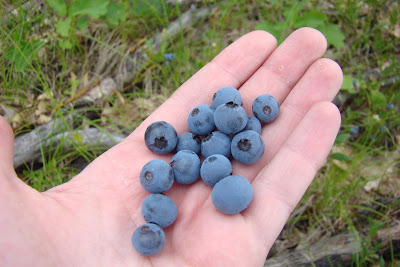
3. Travel. I get to see fun parts of the state/country/world that I normally might bypass as a tourist. For instance, who knew that Sparta, Wisconsin has the largest cemetery for fiberglass animals (you know the huge ones you see at bizarre roadside attractions in the middle of nowhere!) When else am I going to be able to canoe the Kickapoo river or walk into a mile-long tunnel on the Sparta-Elroy Bike Trail? And did you know there's a park in Texas where you can actually step in real fossilized dinosaur foot prints? Or how about, how would you feel about not just visiting the Amazon rainforest but sharing your accommodations with bats and baby owls, washing your clothes in a tributary of the Amazon river and swimming in lakes filled with caymans and piranhas?
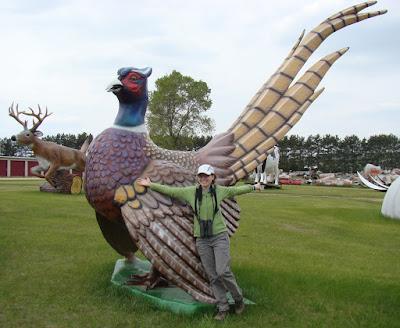
Probably the largest bird I have ever posed with, at the Graveyard for Fiberglass Animals in Sparta, WI
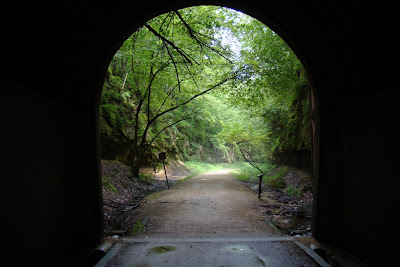
An old train tunnel that has been converted as part of the Sparta-Elroy Bike Trail in Wilton, WI
4. A sense of adventure. Sometimes as I was walking through the army base looking for birds and butterflies, it would feel kind of like I was a kid again pretending to be an explorer in my own backyard. Except this time my backyard was much bigger. And the real US Army was following me! Ha, just kidding. There are some stories though that soldiers have accidentally kidnapped wildlife researchers, mistaking them as part of a military exercise! It almost happened to me, but I was able to explain what I was doing and everything was OK. Whew.
5. Discovery. You never know when you might discover something new, or at least witness something that not many other people get to see. Fort McCoy happens to be a huge reserve for a Federally Endangered species of butterfly, the Karner Blue. Since there are so many of them there, I had a few moments where one would land on my finger and lick the salt off my skin. Here I am, with this tiny endangered butterfly the size of a thumb nail and it's finding nourishment from my sweat!
On another occasion, I sat down to take a picture of this other species of butterfly when I heard some strange squeaking. It turned out three lively and playful badgers were emerging from their den maybe 15 feet away from me. Luckily, I was able to catch it on camera! To give you an idea of how rare it is to see wild badgers during the day, my supervisor has been working all over this same army base for four years and has never seen one. Here's a glimpse:
What's so great about working such an unpredictable job where you often end up covered in scratches, sunburn and bug bites?
Let me tell you!
1. Peace and quiet. OK, I worked on military bases twice now so I can tell you it's not always that quiet or peaceful. But you do get chances to get away from it all. Sometimes there might be some faint gunshots going off in the background, sure. But when you wander through the prairie or deep into the woods, it's just you and nature. You don't have to worry about being bombarded with emails or phone calls, just fresh air and bird songs.
solitude from stephanie on Vimeo.
Peace and quiet at Fort McCoy2. Free Food. Not always a guarantee of course, but something I definitely benefited from this year. Late June brought tons of plump blueberries and blackberries and they were absolutely delicious!
3. Travel. I get to see fun parts of the state/country/world that I normally might bypass as a tourist. For instance, who knew that Sparta, Wisconsin has the largest cemetery for fiberglass animals (you know the huge ones you see at bizarre roadside attractions in the middle of nowhere!) When else am I going to be able to canoe the Kickapoo river or walk into a mile-long tunnel on the Sparta-Elroy Bike Trail? And did you know there's a park in Texas where you can actually step in real fossilized dinosaur foot prints? Or how about, how would you feel about not just visiting the Amazon rainforest but sharing your accommodations with bats and baby owls, washing your clothes in a tributary of the Amazon river and swimming in lakes filled with caymans and piranhas?
Probably the largest bird I have ever posed with, at the Graveyard for Fiberglass Animals in Sparta, WI
An old train tunnel that has been converted as part of the Sparta-Elroy Bike Trail in Wilton, WI
4. A sense of adventure. Sometimes as I was walking through the army base looking for birds and butterflies, it would feel kind of like I was a kid again pretending to be an explorer in my own backyard. Except this time my backyard was much bigger. And the real US Army was following me! Ha, just kidding. There are some stories though that soldiers have accidentally kidnapped wildlife researchers, mistaking them as part of a military exercise! It almost happened to me, but I was able to explain what I was doing and everything was OK. Whew.
5. Discovery. You never know when you might discover something new, or at least witness something that not many other people get to see. Fort McCoy happens to be a huge reserve for a Federally Endangered species of butterfly, the Karner Blue. Since there are so many of them there, I had a few moments where one would land on my finger and lick the salt off my skin. Here I am, with this tiny endangered butterfly the size of a thumb nail and it's finding nourishment from my sweat!
On another occasion, I sat down to take a picture of this other species of butterfly when I heard some strange squeaking. It turned out three lively and playful badgers were emerging from their den maybe 15 feet away from me. Luckily, I was able to catch it on camera! To give you an idea of how rare it is to see wild badgers during the day, my supervisor has been working all over this same army base for four years and has never seen one. Here's a glimpse:
badgers from stephanie on Vimeo.
Hope you enjoyed a look into the life of a field biologist! More to come later.Tuesday, June 22, 2010
Hark! A Horned Lark!
So, now that migration season has long been over I have moved on to a new project that I am working on. I am working at Fort McCoy and studying butterflies. It's a whole new area for me and I'm just learning a ton of new stuff! I have been quite busy lately and haven't had time to update my blog. But hopefully that will change.
Well, I just wanted to take a moment and update with some photos of Horned Larks at Fort McCoy. I don't get to see grassland species like larks very often, so I like to take the time to watch them scuttle across the roads while I'm here. Funny thing is that just after I took the pictures, a few soldiers pulled up in their Humvee and asked if I was OK. And of course they scared away the birds! I thought it best not to explain the whole situation though and just move on home! I'm sure they would have thought I was crazy though, looking at birds while they are busy preparing for war. Anyway, here are the pictures and video...
Horned Lark from stephanie beilke on Vimeo.
Look (and listen) closely! There's a butterfly waving its wings in the background (no I don't know what kind) and the bird you hear singing is a Vesper Sparrow.
Monday, May 10, 2010
A little about leaves
So, a little about leaves....
When it comes to tree identification, of course the most helpful tool is using the leaves. Even during the fall or winter you can pick leaves up off the ground and learn a bit about the vegetation around you.
A little bit about leaves with lobes...
One way to identify leaves is whether or not they are "lobed." Some familiar lobed leaves are Oak and Maple. But there are a few different species in these groups you can learn.
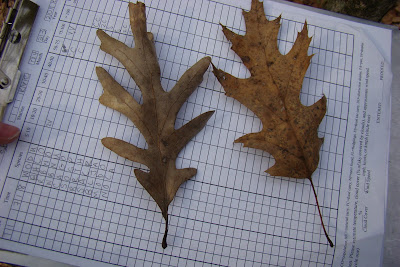 On our study sites, we have several different species of Oak, including Red, White, Burr, Black, and Swamp White. The two leaves pictured above are White (left) and Red (right), two of our more common species. The big thing to look for here is that White Oak leaves have rounded lobes and Red Oak have pointed lobes. It's that easy! But be careful, White oak can also be confused with Swamp White and Burr, which also have rounded lobes. And Red Oak and Black oak both have pointed lobes. Here, it's important to recognize the different patterns and the amounts of space on the leaves instead.
On our study sites, we have several different species of Oak, including Red, White, Burr, Black, and Swamp White. The two leaves pictured above are White (left) and Red (right), two of our more common species. The big thing to look for here is that White Oak leaves have rounded lobes and Red Oak have pointed lobes. It's that easy! But be careful, White oak can also be confused with Swamp White and Burr, which also have rounded lobes. And Red Oak and Black oak both have pointed lobes. Here, it's important to recognize the different patterns and the amounts of space on the leaves instead.
Another lobed leaf plant, Maple. It's absolutely everywhere in our woods at Kickapoo Valley Reserve, especially Sugar Maple. See if you can tell the difference between these two saplings.

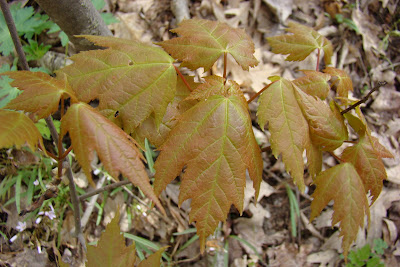 Which one is Red Maple? Well in this case, the color gives it away, but it's not always that easy. During the middle of summer all Red and Sugar maple will have dark green leaves. The thing to look for is the fringe. Sugar maple leaves are more smooth while Red Maple has a more jagged edge. Another hint is that in springtime, Red Maple will have red flowers.
Which one is Red Maple? Well in this case, the color gives it away, but it's not always that easy. During the middle of summer all Red and Sugar maple will have dark green leaves. The thing to look for is the fringe. Sugar maple leaves are more smooth while Red Maple has a more jagged edge. Another hint is that in springtime, Red Maple will have red flowers.
Some things to look for in non-lobed leaves...
 The giveaway for this leaf is its shear size. This is a Basswood leaf and it is much bigger than the rest of the leaves on the ground. It also has an asymmetrical base, one side dips a little lower than the other. As opposed to other non-lobed leaves, such as elm and others, this one is especially rounded.
The giveaway for this leaf is its shear size. This is a Basswood leaf and it is much bigger than the rest of the leaves on the ground. It also has an asymmetrical base, one side dips a little lower than the other. As opposed to other non-lobed leaves, such as elm and others, this one is especially rounded.
 These two leaves pictured above, are both aspen. They look a little similar, but one is from a Big-toothed Aspen and one is from a Quaking Aspen. See the difference? The Big-toothed has big teeth! This is referring to the edge of the leaf which creates a toothlike pattern. The Big-tooth has large dips between the teeth whereas the quaking does not. Another obvious difference here is the size. Of course, on a given tree, leaves will range in size, but as for this Quaking leaf that is about as big as it will get. Also, Quaking Aspen leaves often "quake" or flicker rapidly in the breeze, giving them their name.
These two leaves pictured above, are both aspen. They look a little similar, but one is from a Big-toothed Aspen and one is from a Quaking Aspen. See the difference? The Big-toothed has big teeth! This is referring to the edge of the leaf which creates a toothlike pattern. The Big-tooth has large dips between the teeth whereas the quaking does not. Another obvious difference here is the size. Of course, on a given tree, leaves will range in size, but as for this Quaking leaf that is about as big as it will get. Also, Quaking Aspen leaves often "quake" or flicker rapidly in the breeze, giving them their name.
OK a little about birds too....
Since it's already the second week of May, spring migration is in full swing!! I've been seeing or hearing a new bird almost everyday. Yesterday it was a Red-eyed Vireo and today it was a Swainson's Thrush. Unfortunately, the birds are way up high in the trees and busy as ever, making it hard for me to take pictures of them! So all I have is a lovely yard bird during its migratory stop-over, a White-crowned Sparrow.
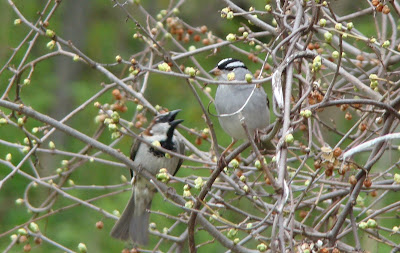
The local House Sparrow seems to be telling the White crown (on the right) he is not welcome in this brush pile, but he seems to be sticking around for a few days anyway, which is quite all right with me.
When it comes to tree identification, of course the most helpful tool is using the leaves. Even during the fall or winter you can pick leaves up off the ground and learn a bit about the vegetation around you.
A little bit about leaves with lobes...
One way to identify leaves is whether or not they are "lobed." Some familiar lobed leaves are Oak and Maple. But there are a few different species in these groups you can learn.
Another lobed leaf plant, Maple. It's absolutely everywhere in our woods at Kickapoo Valley Reserve, especially Sugar Maple. See if you can tell the difference between these two saplings.
Some things to look for in non-lobed leaves...
OK a little about birds too....
Since it's already the second week of May, spring migration is in full swing!! I've been seeing or hearing a new bird almost everyday. Yesterday it was a Red-eyed Vireo and today it was a Swainson's Thrush. Unfortunately, the birds are way up high in the trees and busy as ever, making it hard for me to take pictures of them! So all I have is a lovely yard bird during its migratory stop-over, a White-crowned Sparrow.
The local House Sparrow seems to be telling the White crown (on the right) he is not welcome in this brush pile, but he seems to be sticking around for a few days anyway, which is quite all right with me.
Monday, May 3, 2010
Join us for Bird Banding at Kickapoo Valley Reserve
This Saturday, May 8, we are going to be doing bird banding at Kickapoo Valley Reserve as part of a public demonstration. All are invited to come check out the birds and hopefully some cool spring migrants. Kickapoo Valley Reserve is located around the city of La Farge, Wisconsin, just two hours north of Madison and about and hour southeast of La Crosse.
 Kickapoo Valley Reserve Visitor Center
Kickapoo Valley Reserve Visitor Center
on State Hwy 131
For more information see the Kickapoo Valley Reserve Event Calendar: http://kvr.state.wi.us/event_view_all.asp?locid=115 or this flyer for our banding event: http://kvr.state.wi.us/docview.asp?docid=19127&locid=115
Banding will open to the public 8am-2pm. Another demonstration will be held on May 22 from 4-7pm. Hope to see you there!
 Kickapoo Valley Reserve Visitor Center
Kickapoo Valley Reserve Visitor Centeron State Hwy 131
For more information see the Kickapoo Valley Reserve Event Calendar: http://kvr.state.wi.us/event_view_all.asp?locid=115 or this flyer for our banding event: http://kvr.state.wi.us/docview.asp?docid=19127&locid=115
Banding will open to the public 8am-2pm. Another demonstration will be held on May 22 from 4-7pm. Hope to see you there!
Wednesday, April 28, 2010
Learning some of Wisconsin's trees by bark
As I mentioned in my last post, I have been spending the last few weeks learning trees! It has been a bit difficult since some of the trees are still just leafing out. Fortunately, there are a few trees that are easy to learn, just by looking at the bark.
 The White Ash has bark that forms a weaving pattern, creating little nooks.
The White Ash has bark that forms a weaving pattern, creating little nooks.
 Yellowbud Hickory (also known as Bitternut Hickory) has a similar weaving pattern, except the bark looks like it has been sanded down.
Yellowbud Hickory (also known as Bitternut Hickory) has a similar weaving pattern, except the bark looks like it has been sanded down.
 The Black Cherry Tree has bark that is peeling off in the shape of burnt potato chips.
The Black Cherry Tree has bark that is peeling off in the shape of burnt potato chips.
 Mature Aspen trees have deeply grooved bark at the base that becomes lighter colored and almost birch-like near the top. Seen above and below. This is Big-toothed Aspen.
Mature Aspen trees have deeply grooved bark at the base that becomes lighter colored and almost birch-like near the top. Seen above and below. This is Big-toothed Aspen.
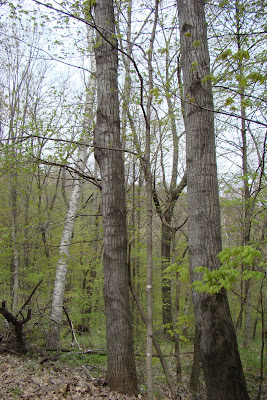
Some more Wisconsin trees that can be easily identified by bark are Yellow Birch, Paper Birch, and Shagbark Hickory. Some of the other more common species, Maples, Oaks and Elms can be a little more difficult. Fortunately, their leaves make things much simpler! More on that later...
 The Black Cherry Tree has bark that is peeling off in the shape of burnt potato chips.
The Black Cherry Tree has bark that is peeling off in the shape of burnt potato chips.Some more Wisconsin trees that can be easily identified by bark are Yellow Birch, Paper Birch, and Shagbark Hickory. Some of the other more common species, Maples, Oaks and Elms can be a little more difficult. Fortunately, their leaves make things much simpler! More on that later...
Thursday, April 22, 2010
Spring Migration 2010
Instead of heading south for the summer like I did last year, this year I decided to head north along with the migratory birds. Last week I drove up to Wilton, WI, just 2 hours north of Madison and nearby the cities of Tomah and Sparta. I'm now relaxing at the lovely farm house we're renting for the spring after a long day in the field (Thanks to our amazing hostess, Donna!!).
My new job is to collect data for Eric, a Ph.D. candidate at the University of Wisconsin Madison. Basically, we are surveying migratory birds using the forests and savannas of Fort McCoy in Tomah and the woods of Kickapoo Valley Reserve in La Farge, WI. The focus is on wood warblers, especially those that have flown all the way here from Central and South America. So far a lot of early migrants have shown up at Kickapoo Valley where we have been collecting data on the vegetation, like Blue-headed Vireos, Yellow-rumped Warblers, Ruby-crowned Kinglets and Hermit Thrushes. However, we're still waiting for the warbler flood gates to crack open.
First things first though, and we have a lot of data to collect in the woods of Wisconsin. I don't think I ever mentioned it in my previous posts, but almost always when you do studies on birds you have to look at their environment and what kind of resources they are using. So that means we have been trawling the woods and identifying trees like mad for the past two weeks. I am definitely not a botanist, so it has been a bit grueling at times, but I'm learning a ton. Some of the really common trees here are White Oak, Red Oak, Basswood, Yellowbud (or Bitternut) Hickory, Red Maple and Sugar Maple. Some are nearly impossible to identify just by bark or shape alone. But fortunately, the oaks are just starting to leaf out now and some of the maples are almost in full summer plumage (hmmm.. ok maybe that's not the right word to describe it!) With the warm weather we've been having, the trees seem to be upping their usual pace, and in turn having an affect on insect populations. Will these factors influence the livelihood of our colorful spring warblers? I guess we have some research work that needs to be done.
My new job is to collect data for Eric, a Ph.D. candidate at the University of Wisconsin Madison. Basically, we are surveying migratory birds using the forests and savannas of Fort McCoy in Tomah and the woods of Kickapoo Valley Reserve in La Farge, WI. The focus is on wood warblers, especially those that have flown all the way here from Central and South America. So far a lot of early migrants have shown up at Kickapoo Valley where we have been collecting data on the vegetation, like Blue-headed Vireos, Yellow-rumped Warblers, Ruby-crowned Kinglets and Hermit Thrushes. However, we're still waiting for the warbler flood gates to crack open.
First things first though, and we have a lot of data to collect in the woods of Wisconsin. I don't think I ever mentioned it in my previous posts, but almost always when you do studies on birds you have to look at their environment and what kind of resources they are using. So that means we have been trawling the woods and identifying trees like mad for the past two weeks. I am definitely not a botanist, so it has been a bit grueling at times, but I'm learning a ton. Some of the really common trees here are White Oak, Red Oak, Basswood, Yellowbud (or Bitternut) Hickory, Red Maple and Sugar Maple. Some are nearly impossible to identify just by bark or shape alone. But fortunately, the oaks are just starting to leaf out now and some of the maples are almost in full summer plumage (hmmm.. ok maybe that's not the right word to describe it!) With the warm weather we've been having, the trees seem to be upping their usual pace, and in turn having an affect on insect populations. Will these factors influence the livelihood of our colorful spring warblers? I guess we have some research work that needs to be done.
Sunday, January 31, 2010
urban hawk banding
Today I got the chance to meet up with Loren, one of the coordinators of the Raptor banding workshop I did in Stevens Point. He's also licensed to trap and band raptors and luckily lives here in town, so we thought we'd try trapping hawks today and see what we could get. It's been several months since I've gotten to handle birds, so maybe I had my expectations set a little high, but I was not disappointed!

Loren with our first catch of the day
Moments after banding our first bird, we were out setting traps after another Rough-legged and an adult Red-tailed hawk perching in the same tree. Unfortunately they were too far out. We had to walk the traps out to get closer to the birds and may have raised their suspicions. They weren't falling for it. Meanwhile, we caught sightings of a skunk walking around in the daylight and three flocks of Tundra Swans!
 After releasing the young Red-tail, he stuck around for awhile perched atop the building before flying away.
After releasing the young Red-tail, he stuck around for awhile perched atop the building before flying away.

After catching two hawks, we took a break for lunch. Alas we should have looked around more for hawks before sitting down! This red-tailed hawk caught it's own lunch just outside the window while we were grabbing sandwiches.
 After catching an immature Red-tail, I suppose the goal now was to get an adult. We tried and failed to catch the red-tail pictured below. He went after the trap, but broke loose! Here in the picture, you can see how the mice are safely contained in the trap. The microfilaments attached to the top of the Bal-chatri Trap work as tiny nooses that catch on the raptor's feet.
After catching an immature Red-tail, I suppose the goal now was to get an adult. We tried and failed to catch the red-tail pictured below. He went after the trap, but broke loose! Here in the picture, you can see how the mice are safely contained in the trap. The microfilaments attached to the top of the Bal-chatri Trap work as tiny nooses that catch on the raptor's feet.
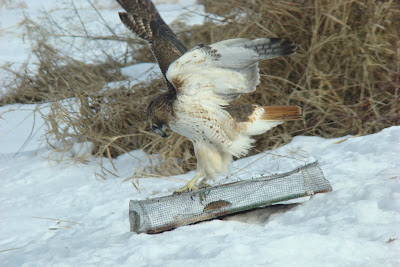
Just as we were about to wrap up the day, we got a good spot on two Red-tails just down the road again from where we got our Rough-legged. We succeeded in getting one of the pair! Loren though it may be the male, judging by its smallish size, and the other may hawk have been its mate. Our adult red-tail still weighed in over 1100 grams. Pretty big, considering most of the birds I'm used to banding weigh around 10 grams!
 So end of the day, we got 3 hawks. And I got to band all of them.. well with a little help of course.
So end of the day, we got 3 hawks. And I got to band all of them.. well with a little help of course.
 Those sure are some "rough" legs.. I guess? A Rough-legged Hawk with some feathery feet!
Those sure are some "rough" legs.. I guess? A Rough-legged Hawk with some feathery feet!
We started out the morning with a Rough-legged Hawk spotted just down the road from our starting point. Not even 5 minutes after baiting the Roughie with deer mice, he was on the trap. Poor guy was clearly hungry, like many birds are in winter. I must admit, I'm more of a songbird birder than a raptor watcher. So, I'm still in the process of learning my local birds of prey! I don't believe I've ever gotten such a good glimpse of a Rough-legged Hawk before, and now he was here in my hand. He was quite stunning, a little bit smaller than a Red-tailed hawk, but with longer wings and a dark brown front. Rough-leggeds are only in Wisconsin for the winter, so they are a little bit more of a rarity compared to Red-tails, which are absolutely everywhere.
 Close-up with a Rough-legged Hawk
Close-up with a Rough-legged Hawk
Loren with our first catch of the day
Moments after banding our first bird, we were out setting traps after another Rough-legged and an adult Red-tailed hawk perching in the same tree. Unfortunately they were too far out. We had to walk the traps out to get closer to the birds and may have raised their suspicions. They weren't falling for it. Meanwhile, we caught sightings of a skunk walking around in the daylight and three flocks of Tundra Swans!
Our next catch was an immature Red-tailed Hawk, another easy catch that flew directly for our trap. We banded him right outside the Lussier Family Heritage Center near a popular walking trail, raising a few strange looks from passersby.
After catching two hawks, we took a break for lunch. Alas we should have looked around more for hawks before sitting down! This red-tailed hawk caught it's own lunch just outside the window while we were grabbing sandwiches.
Just as we were about to wrap up the day, we got a good spot on two Red-tails just down the road again from where we got our Rough-legged. We succeeded in getting one of the pair! Loren though it may be the male, judging by its smallish size, and the other may hawk have been its mate. Our adult red-tail still weighed in over 1100 grams. Pretty big, considering most of the birds I'm used to banding weigh around 10 grams!
Subscribe to:
Posts (Atom)
